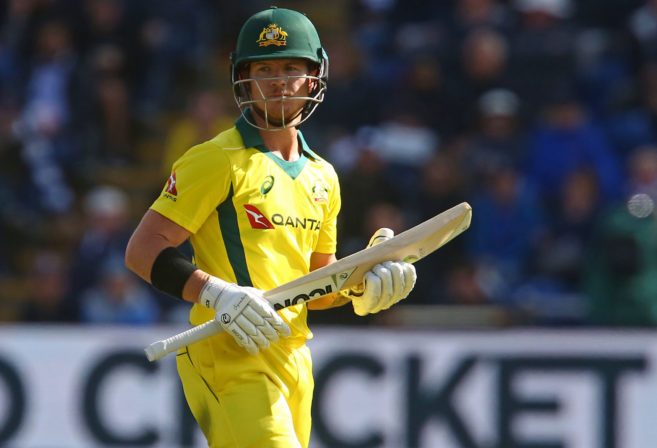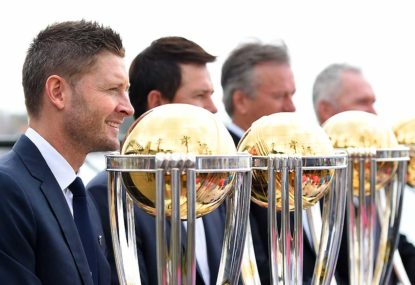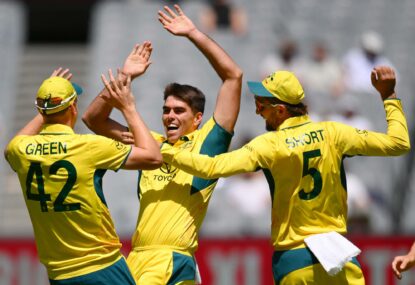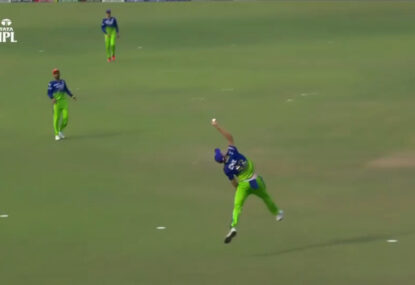The World Cup cricket first moved outside England during the autumn of 1987, as India and Pakistan jointly hosted the fourth World Cup. Also, the format changed with 60-over games replaced by 50-over affairs.
Just prior to the beginning of the event, Allan Border, the Aussie captain, claimed his young team had a good chance of winning the event. I thought that he was joking. In fact, I felt it might become the ‘joke of the year’.
There was some rationale behind my thoughts. Australia went in to this event on the back of five straight losses in ODIs. It should be mentioned here that the pre tournament practice matches weren’t considered as official at that time.
Anyway, the results of Australia’s last five ODIs before the 1987 World Cup were;
MCG, 8th Feb: Australia 8/171 (Dean Jones 67, Graham Dilley 3/32) def. by England 4/172 (Ian Botham 71 from 52 balls) (The match was reduced to 44 overs per innngs)
SCG, 11th Feb: England 9/187 def. Australia 8/179 (Ian Botham 3/26)
Sharjah, 3rd April: Australia 9/176 (David Boon 71) def. by Pakistan 4/180 (Javed Miandad 74*)
Sharjah, 5th April: Australia 6/176 (David Boon 62) def. by India 3/177 (Md. Azharuddin 84)
Sharjah, 9th April: England 6/230 (Graham Gooch 86) def. Australia 219 (Allan Border 84, Boon 73)
Their last victory prior to the World Cup was against the West Indies at the SCG in February. Even then, on a turning track, their top order struggled against the gentle spin of Roger Harper and Viv Richards before eventually reaching 195/8 for a two-wicket win.
So, it’s clear from the scores that the Aussie batting was struggling. The defeat against England at Sharjah was especially painful as, chasing 231 for victory, they reached 2/166 but still threw it away.
Changes in the team
Obviously, there were a number of changes in the Aussie team in a bid to end the losing streak. Three notable absentees from the World Cup team were Greg Ritchie (one of my favourites), Greg Matthews and Simon Davies. Ritchie paid for his inability to convert starts in to scores and he never played for Australia again.
Matthews’ exclusion was a bit of a mystery, because he had done well in India a year earlier. It possibly had something to do with disciplinary problems.
Davies was a limited over specialist known for his accuracy. His economy of 3.37 was impressive, even for those days’ standards, but the selectors felt the need for a wicket-taking option and opted for the much quicker Craig McDermott.
The changes saw the introduction of two WA players in the middle order; Mike Veletta and Tom Moody. Tim May from South Australia came as a specialist off spinner and joined Peter ‘Who’ Taylor.
The most interesting change saw McDermott return to partner Bruce Reid with the new ball. The Queensland fast bowler was quick, but often erratic. He was encouraged, however, to bowl fast and straight and was used as a wicket-taking weapon.
The Campaign
Australia’s successful bid for the World Cup started at Chennai, on October 9, exactly six months after the Sharjah fiasco. In a nailbiting finish, they beat India by one run.
Steve Waugh bowled Maninder Singh with the fifth ball of the 50th over. McDermott took 4/56; going for wickets and not bothering about the economy.
Overall, Australia won five of their six group matches but still finished second, behind India on run rate.
[latest_videos_strip category=”cricket” name=”Cricket”]
In the semi-final, they defeated Imran Khan’s Pakistan at Lahore. Usual solid batting by the top order combined with some hostile bowling by McDermott ensured the Aussies upset the favourites. But, despite this success, they went in to the final as the underdogs against the arch rivals England.
England had just dethroned India from their title and, more importantly, over the previous 12 months or so they had dominated their old rivals in all forms of the game.
After securing the Ashes with a thumping victory at MCG; they defeated their old rivals on New Year’s day in a 50-over match at the WACA. Then at the SCG, later in January, Australia snatched defeat from the jaws of victory.
They, however, had one thing in their favour. Most of the 70,000 crowd, unhappy about England beating the hosts, were behind the Aussies. Urged on by them, Allan Border’s men lifted the trophy. The defining moment involved both the captains, as Mike Gatting’s infamous reverse sweep shot virtually handed the trophy to his opponents.
What went right
Top order batting clicking. Throughout the event, the Aussie top three of David Boon, Geoff Marsh and Dean Jones scored consistently.
While the Sharjah quadrangular proved a disaster for Australia, one bright spot was the return to form of the Tasmanian Boon. After struggling against the varied English attack during the 1986-87 season; he got back his confidence in the slow pitchers at Sharjah.
Here, he and his opening partner Marsh regularly gave Australia solid starts. The idea for the top three was, once set they would try to bat until the very end. It might seem old-fashioned now, but at the time it worked wonderfully well.
They also took wickets at the right time. Throughout the event, the Aussie team showed great ability in picking up wickets just at the right time.
The return of McDermott helped greatly in this account. He started the event with 4/56 against India, but his most memorable effort came at Lahore when his 5/44 restricted the strong Pakistani batting line up and earned him a man of the match award. Also, the Aussie fielders excelled – getting some vital run outs every now and then.
There were also some great performances from some unsung heroes.
Eight Tests and 20 ODIs isn’t enough for Mike Veletta to find a permanent place in Aussie cricket history books. Still, for the knockout matches of the 1987 event, he became Australia’s unsung hero with some quick cameos.
He got his chance after his fellow WA-man Moody failed in the middle order. A solid opening bat and a wicketkeeper, he was tried as a specialist middle order batsman. He started with a duck against New Zealand but then found his form, scoring 43 (off 39 balls) against Zimbabwe, followed by 48 (50) against Pakistan and 45* (31) in the final against England.
His strike rate of over 110 may seem slow in the modern game, but was brilliant in those days.
The regular keeper, Greg Dyer from NSW, was known for his big hitting but didn’t get much chance to show his aggressive batting. He still managed to grab some headlines with a famous catch to dismiss the England captain at Eden Gardens.
The current situation
Right now, the morale of the Australian cricketers is extremely low after the 5-0 drubbing in England. Yet, things can change very quickly before the start of the next World Cup.

It was a series to forget for Australia against England. (GEOFF CADDICK/AFP/Getty Images)
These are the things they need to get right.
Play a strong bowling line up: My feeling is that the next World Cup will be decided by the bowlers. Whether it will be pace bowlers like Mohammed Amir and Josh Hazlewood or spinners like Kuldeep Yadav or Adil Rashid, I expect the bowlers to have the bigger say.
In this scenario, I expect the Aussies to play their strongest pace attack of Mitchell Starc, Josh Hazlewood and Pat Cummins. They all have enough experience in England and should form the strongest possible pace attack for Australia. Nathan Lyon should be the first choice spinner, because nowadays it’s not enough for a spinner to bowl just ten economical overs.
I wouldn’t ignore Adam Zampa either. His ODI record is still impressive despite his slump in form over the last year or so. He can be used as a part of the ‘horses for courses’ plan. Ashton Agar can only make it as an allrounder, although there are many medium pace bowling allrounders available as well.
Get a good captain: Tim Paine has underperformed in the recent series; both as a player and as a captain. His batting average of just over 40 in Tests looks impressive for a keeper; but it is difficult to fit him properly in the ODI line up. One feels the Aussies need more active leadership on the field from someone who has greater international experience.
Sort the batting line up: For some inexplicable reason, Aaron Finch was tried at the number five position for couple of matches in the recent series. The good thing is that he failed and the experiment has stopped. In my view, he should either be opening the innings, or not in the team at all.
It is important for the Aussie batting line up to clearly define the roles for different batsmen. In the England team, the role of Alex Hales is not the same as Root’s. A timely return of the banned players may help the Aussies to go into the World Cup with a more balanced line up.
The conclusion is that it’s just too early to write off the Aussies before the start of the next World Cup. They may not be the favourites; but it will be foolish to forget them.






































































































